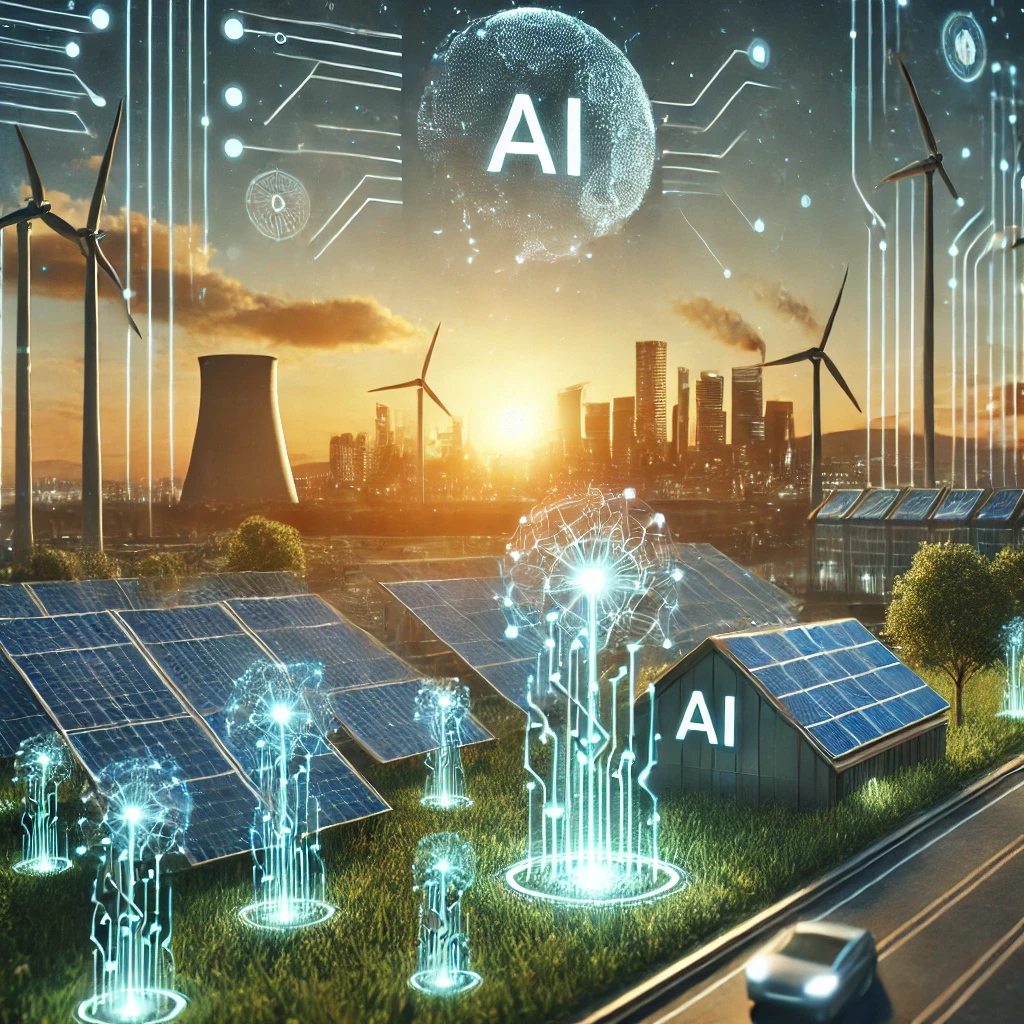
Explore how AI is revolutionizing green energy in 2024 by optimizing renewable energy generation, improving energy storage, and enabling smart grids for a more sustainable future.
AI Revolutionizing Green Energy Optimization in 2024
As the world grapples with the growing threats of climate change and environmental degradation, artificial intelligence (AI) has emerged as a crucial tool in helping nations meet their sustainability goals. In 2024, AI is transforming the way renewable energy sources, such as solar and wind, are being optimized, enabling more efficient and reliable energy production and distribution. While green energy holds the key to a more sustainable future, the inherent variability in renewable resources has long posed challenges in ensuring a consistent and stable energy supply. This is where AI steps in, offering unprecedented solutions to optimize energy systems, manage resources, and predict fluctuations with remarkable accuracy.
With an increasing number of governments and organizations committed to reducing carbon footprints and transitioning to cleaner energy, the demand for smarter, AI-driven technologies in energy management is greater than ever before. This article explores the key ways in which AI is revolutionizing the renewable energy sector, from improving energy storage solutions to creating AI-powered smart grids that can autonomously regulate energy flow. We will also examine the potential challenges and ethical considerations as AI becomes more deeply integrated into energy systems.
The Renewable Energy Challenge: Why AI is Critical in 2024
The global demand for energy is soaring, driven by economic growth, population expansion, and the rapid digital transformation of industries. However, the environmental cost of relying on fossil fuels—such as coal, oil, and natural gas—is becoming increasingly unsustainable. Renewable energy sources like solar power, wind power, geothermal energy, and hydropower offer a promising alternative, but they come with a significant challenge: variability. Solar panels only generate energy when the sun is shining, and wind turbines depend on wind patterns, which can change unpredictably. These fluctuations make it difficult for energy providers to match supply with demand, leading to inefficiencies and, at times, energy shortages or excess production.
Enter AI: A Game-Changer for Renewable Energy
In 2024, AI is proving to be a game-changer for managing renewable energy resources. Thanks to advancements in machine learning and data analytics, AI systems are now capable of predicting energy production and demand with a high degree of accuracy. By analyzing historical weather patterns, real-time environmental data, and energy consumption trends, AI-driven models can forecast how much energy will be produced from renewable sources in any given time frame. This predictive capability is essential for ensuring that energy grids can balance supply and demand, reduce wastage, and avoid costly reliance on non-renewable backup sources.
AI’s Role in Addressing Energy Demand Surges
AI is not just about managing energy production; it’s also about meeting surges in energy demand. For instance, during heatwaves or cold spells, energy demand can skyrocket as people rely on air conditioning or heating systems. Traditionally, this required firing up fossil-fuel-powered peaker plants, which are costly and environmentally damaging. AI, however, enables energy providers to better manage these peaks by predicting when demand will increase and adjusting renewable energy production accordingly. This reduces the need for carbon-intensive backup systems, helping to create a greener energy grid.
AI and Energy Storage: Solving the Renewable Intermittency Problem
One of the biggest challenges in renewable energy is the issue of intermittency—the fact that energy production is not constant due to changing environmental conditions. This is particularly problematic for solar and wind power, which can experience drastic fluctuations in energy output. Without proper management, energy surpluses are wasted, and deficits lead to over-reliance on fossil fuels. The solution to this problem lies in effective energy storage, and AI is playing a critical role in optimizing storage technologies, ensuring that excess energy is saved for later use.
The Importance of AI in Battery Storage Systems
In 2024, AI is driving significant improvements in battery storage systems. By leveraging machine learning algorithms, AI can predict when energy production will exceed demand and signal the need to store excess energy in batteries. Conversely, it can also predict when energy production will fall short, ensuring that stored energy is released at the right time to meet demand. This level of precision in managing energy storage is key to making renewable energy more reliable and efficient.
Battery Management Systems (BMS)
AI is now being integrated into battery management systems (BMS) to optimize how energy is stored, managed, and distributed. AI-driven BMS can analyze data in real-time, ensuring that batteries are charged during peak production times and discharged during periods of high demand. This not only improves energy efficiency but also extends the lifespan of the batteries by preventing overcharging or undercharging, which can lead to battery degradation. The ability of AI to predict and respond to real-time energy needs is revolutionizing the way energy storage systems are managed.
Enhancing Large-Scale Energy Storage Solutions
In addition to residential battery storage solutions, AI is also improving large-scale energy storage systems, such as grid-scale batteries. These batteries store excess energy produced by solar farms and wind farms and release it when the grid needs it most. AI algorithms can predict when grid-scale batteries should be charged and when to release stored energy, helping to stabilize the grid and reduce reliance on non-renewable backup power sources.
AI in Hydrogen Storage
Another exciting development in renewable energy storage is the growing use of hydrogen as a clean energy carrier. AI is playing an important role in optimizing hydrogen production and storage by analyzing data on renewable energy production, hydrogen demand, and market prices. AI algorithms can determine the best times to produce and store hydrogen, making the entire process more cost-effective and efficient. Hydrogen can then be used to generate electricity when renewable energy production is low, providing a clean, reliable energy source.

AI-Driven Smart Grids: Building the Future of Energy Infrastructure
While AI’s contributions to renewable energy management and storage are impressive, its impact on smart grids may be its most transformative application yet. In 2024, smart grids powered by AI are enabling energy providers to create more flexible, resilient, and efficient energy systems. These grids can autonomously regulate the distribution of energy, ensuring that power is delivered where it is needed most and reducing the likelihood of blackouts or other disruptions.
What Are Smart Grids?
Smart grids are energy distribution networks that use digital communication technologies to monitor and manage the flow of electricity from producers to consumers. Unlike traditional grids, which rely on centralized control and manual processes, smart grids can make real-time adjustments based on data from sensors and meters. This allows for more dynamic energy management, reducing inefficiencies and improving the reliability of the energy supply.
The Role of AI in Smart Grids
AI is the driving force behind the automation of smart grids. By analyzing data from millions of sensors spread across the grid, AI systems can predict energy demand, identify potential problems, and optimize energy distribution. For example, if one area of the grid is experiencing high demand, AI can divert energy from areas with lower demand or signal battery storage systems to release stored energy. This not only improves the efficiency of the grid but also reduces the risk of overloading and blackouts.
Demand Response and Load Balancing
A key feature of AI-powered smart grids is their ability to perform demand response and load balancing. Demand response refers to the ability of the grid to adjust energy consumption in response to supply constraints. AI can signal industrial consumers to reduce their energy usage during peak times or incentivize households to shift their energy use to off-peak hours. Load balancing, on the other hand, ensures that energy is evenly distributed across the grid, preventing bottlenecks and reducing stress on power lines.
Grid Security and Resilience
AI is also playing a crucial role in improving the security and resilience of smart grids. Cyberattacks on energy infrastructure are a growing concern, particularly as more of the grid becomes digitalized. AI-driven cybersecurity systems can monitor grid activity, detect potential threats, and respond to attacks in real-time, ensuring that energy infrastructure remains secure. Additionally, AI can help predict and mitigate the effects of natural disasters, such as storms or wildfires, by optimizing grid operations and ensuring that energy is distributed efficiently during emergencies.
Case Study: AI in Action—Google’s Renewable Energy Initiative
One of the most notable examples of AI being used to optimize renewable energy comes from Google, which has been a pioneer in AI-driven sustainability. In recent years, Google has committed to running its global operations entirely on carbon-free energy by 2030. To achieve this ambitious goal, the tech giant has turned to AI to optimize its renewable energy usage and minimize its carbon footprint.
How Google Uses AI for Renewable Energy Optimization
Google is using AI developed by its DeepMind division to optimize its data centers’ energy consumption. These AI algorithms predict energy demand at each of Google’s data centers, allowing the company to adjust its renewable energy usage in real-time. For example, on sunny days, Google’s solar panels generate excess energy, which is stored in batteries and used later when energy demand is higher. DeepMind’s AI systems also optimize how Google buys renewable energy from the grid, ensuring that the company is using the cleanest, most efficient energy sources available.
The Results
Thanks to AI, Google has been able to reduce the energy used by its data centers by 30% and has made significant progress toward its goal of running on 100% renewable energy. The company’s success in integrating AI with renewable energy systems has served as a model for other tech companies and industries looking to reduce their carbon footprints and improve energy efficiency.
Challenges and Ethical Considerations of AI in Energy
While AI offers significant benefits in optimizing green energy, it also raises important challenges and ethical considerations. One of the primary concerns is the potential for algorithmic bias in energy distribution. If AI systems prioritize certain regions or demographics over others, it could result in unequal access to energy, particularly in underserved or rural communities. Ensuring that AI systems are transparent and that their decision-making processes are fair and equitable is a crucial issue that energy providers must address.
Data Privacy in AI-Driven Energy Systems
Another challenge is the issue of data privacy. AI systems rely on vast amounts of data to make decisions, including personal and environmental information. Ensuring that this data is protected and used responsibly is critical to maintaining public trust. Additionally, regulators will need to implement safeguards to prevent the misuse of data and ensure that AI systems operate transparently.
The Future of AI in Green Energy
Looking forward, AI’s role in the energy sector is only set to expand. The development of quantum computing promises to further enhance AI’s capabilities, allowing it to process even larger datasets and make more accurate predictions. Additionally, the integration of AI with other emerging technologies, such as blockchain and IoT (Internet of Things), could create more decentralized and secure energy systems, enabling communities to share and distribute renewable energy more equitably.
AI Paving the Way for a Sustainable Future
In 2024, AI is at the forefront of the green energy revolution, offering solutions to some of the most pressing challenges in renewable energy management, storage, and distribution. From improving the efficiency of solar and wind farms to optimizing energy storage and powering smart grids, AI is helping to create a more sustainable and resilient energy system. As the world continues to transition away from fossil fuels, AI will play an increasingly critical role in ensuring that renewable energy can meet the growing global demand for clean, reliable power.
With its ability to analyze vast amounts of data, make real-time decisions, and optimize energy systems, AI is not just a tool for the future—it’s shaping the future of energy today.
AI and the Future of Green Energy
As we continue to face the urgent challenges of climate change, AI’s role in transforming the energy sector is becoming ever more crucial. In 2024, AI is not just an added advantage for renewable energy—it’s an essential driving force in optimizing efficiency, reducing costs, and ensuring reliable energy distribution. By enhancing energy storage, improving predictive models, enabling smart grids, and creating real-time energy management systems, AI is laying the foundation for a more sustainable energy future.
The success of AI in green energy systems, like Google’s renewable energy optimization initiative, serves as a testament to the potential of technology in addressing the complexities of modern energy needs. The ability to predict energy demand, adjust production in real time, and manage fluctuations in renewable energy sources is ushering in a new era of energy solutions.
As AI continues to evolve, its integration with other technologies such as quantum computing, blockchain, and the Internet of Things (IoT) will open even greater possibilities for energy systems. In the future, AI-powered decentralized energy grids and more efficient energy-sharing models will pave the way for a more democratized, sustainable, and resilient energy landscape. However, as we embrace these advancements, we must remain mindful of the ethical considerations and challenges—particularly in terms of equity and data privacy—that accompany the widespread adoption of AI in energy systems.
For a more sustainable and environmentally conscious future, AI is proving to be the linchpin in optimizing renewable energy resources and creating a greener planet for future generations. As the world moves closer to a carbon-free future, AI will continue to be an indispensable tool in meeting the growing demand for energy while protecting the environment.
FAQs
- How does AI improve energy efficiency in renewable energy systems?
- AI optimizes the use of renewable energy sources like solar and wind by predicting energy production and consumption patterns, helping energy providers balance supply and demand.
- Source: https://www.ieee.org
- What role does AI play in energy storage?
- AI predicts energy production and consumption fluctuations, guiding when to store excess energy and when to release stored energy to meet demand, improving battery storage systems.
- Source: https://www.nrel.gov
- Can AI help reduce carbon emissions in the energy sector?
- Yes, AI helps reduce reliance on fossil fuels by optimizing the use of renewable sources, managing energy flow more efficiently, and reducing waste.
- Source: https://www.energy.gov
- What are the ethical concerns surrounding AI in energy systems?
- Key concerns include algorithmic bias, unequal energy access, and data privacy issues. Ensuring fairness, transparency, and privacy in AI-driven systems is critical.
- Source: https://www.cnbc.com
- How is AI used in smart grids?
- AI is central to smart grids, enabling real-time monitoring, energy flow management, demand response, and automated responses to energy needs, improving grid efficiency.
- Source: https://www.smartgrid.gov
Did you find this helpful? If you did, please share and stay tuned to our blog!!


